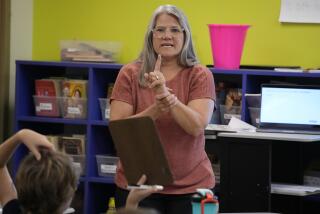Doing the math can pay big dividends
- Share via
It’s been a number of years since I’ve taken an algebra or geometry course. And frankly, though I muddled through math with above average marks, figuring out the length of a hypotenuse or solving for the always elusive x just never seemed all that fun. Or pertinent, really.
I was wrong.
Benedict Carey’s debut young adult novel, “The Unknowns,” weaves together mystery, math and some pretty quirky kids in a unique adventure. His unlikely heroes reside on a small island in the town of Adjacent, a “misfit colony at the end of time,” which is actually no more than a collection of forlorn, seen-better-days trailers that house forlorn, seen-better-days people, most of whom work at the island’s ominous nuclear plant. Carey’s vivid descriptions highlight that Adjacent is in no way a vacation destination: “Old cars, sitting on blocks in people’s yards. Rusted-out vans, turning red-black in the sun.” Add in Trashmore, “the infested mound of reeking garbage,” and you have to wonder why anyone would want to keep this place going.
As it turns out, Adjacent’s very existence, to the likely delight of math teachers everywhere, depends on the numerical skills of two highly underestimated outcasts: the frequently belittled Diaphanta, a.k.a. Princess Di, who absent-mindedly twirls her wrist when she’s anxious, and timid “Tamir Abu Something Something al-Khwarizmi” (nicknamed Tom Jones), who has crazy visions and walks sideways. When Mrs. Clarke, their elderly math mentor, goes missing the summer before seventh grade, Di and Tom learn that they can save her, and maybe all of Adjacent, by solving a trail of nebulous numerical clues she’s left behind for them.
By the numbers
Part of this story’s appeal is that Carey, a former Times staff writer, uses everyday math concepts as an integral part of the mystery, with each clue building on the next. Believe me, these math problems are tough, involving geometry, line graphs and the slopes of triangles. The book is laced with numerous diagrams and maps that the kids draw as visual aides to the many math stumpers throughout. Young readers will undoubtedly pore over them, right along with Di and Tom, trying to make sense of the angles and lines. In the few cases that my addled brain was able to manipulate the numbers correctly, I rejoiced along with the characters. Each subsequent math problem leads the duo deeper into the evil-doings that seem to be going on at the neighboring nuclear plant while also, ironically, leading them underground into a series of large pipes that crisscross the island.
Carey’s offbeat but oh-so-lovable characters possess eccentricities that ultimately turn out to be their greatest strengths. As Di and Tom try to piece together Mrs. Clarke’s message to them, they are forced to enlist the help of Hamilton “Ham” Rowan, an obnoxious bully who once dug his way through Trashmore but emerged with a twitch and glazed-over eyes. Later, we meet the once bright, athletic Thea, who, after nearly drowning in a water-skiing mishap, became a quiet, angry shell of her former self. And finally, there’s Oki, a computer genius who lives in the poorest, dingiest part of Adjacent, and that’s saying something.
Learning to trust
Together, this mismatched group bands together to figure out what the nuclear plant operators are hiding and to stop them from running Adjacent’s residents off the island. They undertake some hair-raising adventures, battle each other along with their own insecurities and land themselves in hot water -- literally, since one of the underground pipes spews boiling water several times a minute.
There are moments when the mystery gets bogged down by the hemming and hawing of Tom and Di and their lengthy mathematical musings. The ultimate “outing” of the evil power plant’s secret is also a little underwhelming. Still, seeing Di and Tom celebrated as heroes overrides these drawbacks. Ultimately, this reader’s favorite moments of the story had nothing to do with tunnels or numbers and more to do with the bonds of friendship and loyalty between the characters. The distrust and animosity that pervades the earliest interactions between these seemingly incompatible teens gradually gives way to reluctant respect and confidence, even as the kids learn to rely and trust themselves as well.
The best books are those that surprise and challenge, capture the imagination and quicken the pulse. Carey manages to do all of that. And when the last math problem is solved, and readers have left Adjacent and its residents behind, they may secretly wish that Di, Tom and their posse could turn up in math class someday, scratching out circle maps in the dirt and seeing number lines in rows of everyday objects.
--
Fry is a former middle school teacher who writes textbook materials for the Teachers’ Curriculum Institute.
More to Read
Sign up for our Book Club newsletter
Get the latest news, events and more from the Los Angeles Times Book Club, and help us get L.A. reading and talking.
You may occasionally receive promotional content from the Los Angeles Times.








